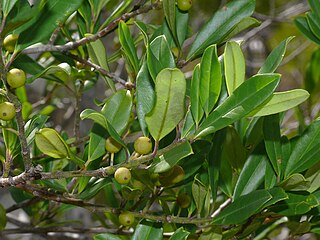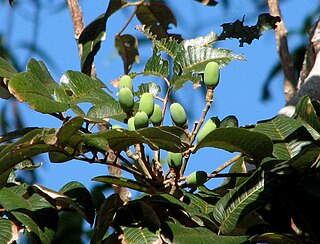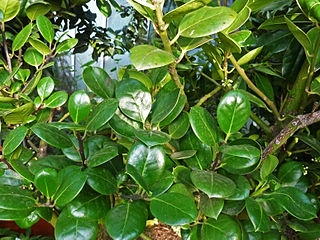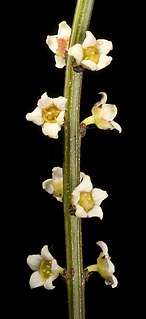
Ilex cassine is a holly native to the southeastern coast of North America, in the United States from Virginia to southeast Texas, in Mexico in Veracruz, and in the Caribbean on the Bahamas, Cuba, and Puerto Rico. It is commonly known as dahoon holly or cassena, the latter derived from the Timucua name for I. vomitoria.

Casuarina is a genus of 17 tree species in the family Casuarinaceae, native to Australia, the Indian subcontinent, southeast Asia, islands of the western Pacific Ocean, and eastern Africa. It was once treated as the sole genus in the family, but has been split into four genera.

Ilex aquifolium, the holly, common holly, English holly, European holly, or occasionally Christmas holly, is a species of flowering plant in the family Aquifoliaceae, native to western and southern Europe, northwest Africa, and southwest Asia. It is regarded as the type species of the genus Ilex, which by association is also called "holly". It is an evergreen tree or shrub found, for example, in shady areas of forests of oak and in beech hedges. In the British Isles it is one of very few native evergreen trees. It has a great capacity to adapt to different conditions and is a pioneer species that repopulates the margins of forests or clearcuts.

Petalostigma is a genus of plants under the family Picrodendraceae and the monogeneric subtribe Petalostigmatinae, first defined by von Mueller in 1857. It is native to New Guinea and Australia.

Ilex mucronata, the mountain holly or catberry, is a species of holly native to eastern North America, from Newfoundland west to Minnesota, and south to Maryland and West Virginia.

Ilex guayusa is a species of tree of the holly genus, native to the Amazon Rainforest. One of three known caffeinated holly trees, the leaves of the guayusa tree are dried and brewed like a tea for their stimulative effects.

Callitris columellaris is a species of coniferous tree in the family Cupressaceae, native to most of Australia. Common names include White Cypress-pine, Murray River Cypress-pine, and Northern Cypress-pine. Callitris columellaris has become naturalised in Hawaii and in southern Florida.

Mirbelia is a plant genus belonging to the family Fabaceae. It is endemic to Australia, occurring in every mainland state except South Australia.

Canarium australianum is a species of trees, native to Australia and Papua New Guinea, of the plant family Burseraceae. Common names include mango bark, scrub turpentine, carrot wood, parsnip wood, Melville Island white beech and brown cudgerie.

Maytenus is a genus of flowering plants in the family Celastraceae. Members of the genus are distributed throughout Central and South America, Southeast Asia, Micronesia and Australasia, the Indian Ocean and Africa. They grow in a very wide variety of climates, from tropical to subpolar. In 2017, a taxonomic review moved 123 species of Maytenus to a new genus, called Monteverdia.

Trachymene is a genus of herbs in the family Araliaceae. The species are native to Australia, Malesia, New Caledonia and Fiji.

Ilex, or holly, is a genus of about 480 species of flowering plants in the family Aquifoliaceae, and the only living genus in that family. The species are evergreen or deciduous trees, shrubs, and climbers from tropics to temperate zones worldwide. The type species is Ilex aquifolium, the common European holly used in Christmas decorations and cards.
Hannafordia is a genus of flowering plants native to Australia

Adenanthos detmoldii, commonly known as Scott River jugflower or yellow jugflower, is a species of shrub in the family Proteaceae. It is endemic to the south-west of Western Australia.

Grevillea ilicifolia, commonly known as holly grevillea, is a species of the plant genus Grevillea. It is a shrub of variable form, growing to between 0.3 and 2 metres in height and 3 metres wide. Typically, leaves are lobed and holly like, but may also be unlobed. The flowers have perianths that have a base that is cream to green grading to grey-mauve. Styles may be pink, red, orange or yellow. The main flowering period in the species' native range is September to November.
Grevillea stenobotrya is a shrub in the family Proteaceae. It is endemic to arid regions of Australia. Common names include rattle-pod grevillea, sandhill grevillea and sandhill spider flower. Plants grow to between 1.5 and 6 metres in height and have leaves are linear and entire, or occasionally divided, and between 6 and 28 cm long and 0.7 to 2.5 mm wide. Flowers are cream, pale yellow or pale pink. These appear in clustered spikes at the end of branches between May and December in the species' native range. The fruits which follow are hard, flattened and rounded and have a short beak.
Maytenus bilocularis, commonly known as orangebark, is a tree that is endemic to eastern Australia. It grows to 10 metres high and has leaves with toothed edges that are 3 to 9 cm long and 1.3 to 3 cm wide and elliptic, ovate or obovate in shape.

Newcastelia is a genus of flowering plants in the mint family, Lamiaceae, first described in 1857 by Ferdinand von Mueller, who placed it in the family, Verbenaceae. The entire genus is endemic to Australia.
- Newcastelia bracteosaF.Muell. - Western Australia, South Australia, Northern Territory
- Newcastelia cephalanthaF.Muell. - Western Australia, South Australia, Northern Territory, Queensland
- Newcastelia cladotrichaF.Muell. - Western Australia, Northern Territory
- Newcastelia ellipticaMunir - Western Australia, Northern Territory
- Newcastelia hexarrhenaF.Muell. - Western Australia
- Newcastelia insignisE.Pritz. - Western Australia
- Newcastelia interruptaMunir - Queensland
- Newcastelia roseoazureaRye - Western Australia
- Newcastelia spodiotrichaF.Muell. - Western Australia, South Australia, Northern Territory
- Newcastelia velutinaMunir - Queensland

Ilex perado, the Macaronesian holly, is a species of holly endemic to Macaronesia, distributed throughout the Azores, Madeira and Canary islands. It is an important component of the natural high-altitude Macaronesian rainforest, known as 'laurisilva', found mostly at 500 to 1,200 m altitude but it also appears in forest formations at lower altitudes. Many of the subspecies have been classified as threatened, probably because of very small population sizes, and are protected by local, national and regional legislation.

Psammomoya is a genus of plants in the Celastraceae family, endemic to Western Australia. The genus was first described by Ludwig Diels and Ludwig Eduard Theodor Loesener in 1904, with the designated type species being Psammomoya choretroides.
















